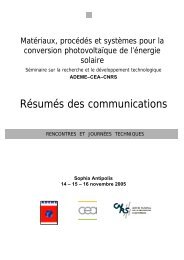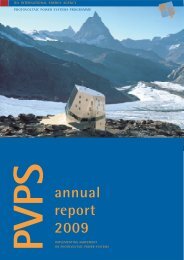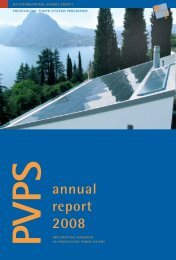Annual Report 2010 - IEA Photovoltaic Power Systems Programme
Annual Report 2010 - IEA Photovoltaic Power Systems Programme
Annual Report 2010 - IEA Photovoltaic Power Systems Programme
Create successful ePaper yourself
Turn your PDF publications into a flip-book with our unique Google optimized e-Paper software.
DENMARK<br />
53<br />
renewable energy sources including waste incineration. Ongoing<br />
research, development and demonstration of new energy solutions<br />
including renewable energy sources have high priority in the present<br />
energy plan, the two main objectives being the development of a<br />
future environmental benign energy system and a high degree of<br />
security in the energy supply many years ahead, both at favourable<br />
cost to consumers.<br />
In September <strong>2010</strong> the so called Climate Commission appointed<br />
by the Government reported on the possibilities to reach the<br />
Government vision of a fossil fuel free energy system by 2050; the<br />
report is regarded as a tool box from which the politicians can select<br />
instruments. Renewable energy technologies, in particular wind, play<br />
an important role, but PV is just seen as one among other emerging<br />
renewable energy technologies to be prioritized when found viable.<br />
<strong>Photovoltaic</strong> technology (PV) is not specifically mentioned in the<br />
government's energy plan, but in early 2004, the Danish Energy<br />
Authority (EA) in collaboration with the electricity sector, the<br />
industry and other key stakeholders finalized a national strategy<br />
on PV after a public hearing. This PV strategy includes the fields of<br />
research, development and demonstration. Deployment activities<br />
in support of the PV strategy are envisaged to be developed in the<br />
coming years and an overall framework for the coordination of PV<br />
development and deployment in Denmark is thus envisaged to be in<br />
place inside a few years. The PV strategy was updated mid 2006 by<br />
way of an annex outlining the need for long term operational targets<br />
and support mechanisms for demonstration. A full update has been<br />
completed in 2009 including the need for large scale demonstration<br />
or deployment instruments, but so far, no political decision on<br />
supporting instruments are in place.<br />
Key actors have been identified as: Utilities - carrying out small<br />
and large R&D and in particular demonstration projects; transmission<br />
system operators - identifying potentials and unresolved issues<br />
related to PV in a large network; universities and institutions -<br />
carrying out R&D activities on PV technology and its application<br />
& integration; professional consultants - catalysing a broad range of<br />
PV projects; industry - developing and manufacturing PV components<br />
and systems; NGO's - disseminating information and the general<br />
public - exhibiting a steady interest in and willingness to buy PVs,<br />
if conditions can be established resulting in a simple pay-back time<br />
of less than 20 years.<br />
Regions and municipalities are playing an increasingly more active<br />
role in the deployment of PV as an integral element in their respective<br />
climate and energy plans.<br />
NATIONAL PROGRAM<br />
Denmark has no unified national PV programme, but a number of<br />
projects supported mainly by the Danish Energy Authority and via<br />
the Public Service Obligation (PSO) of Danish transmission system<br />
operator, Energinet.dk, a fully government owned body. In late 2006,<br />
a new support mechanism, the Energy Development and<br />
Demonstration <strong>Programme</strong> (EUDP), administered by an independent<br />
board and with the Energy Authority as secretariat was announced.<br />
A first call for proposals was closed in September 2007 and has been<br />
followed by several calls. A few PV projects have since received<br />
support, but the real extent to which PV really can benefit from this<br />
instrument with growing funding is not yet known.<br />
A new support instrument administered by Energinet.dk has been<br />
introduced covering 2008 and 4 years ahead targeting demonstration<br />
of PV, wave power and other “emerging technologies.” The first<br />
concrete PV related result of this new support instrument has been<br />
a grant of 22 MDKK for a project to demonstrate 1 MW PV on the<br />
buildings of the Skive municipality. This project is expected to have<br />
a significant replication potential, and the regional municipality of<br />
Bornholm is now considering a major PV initiative. This has been<br />
followed by the PV Island Bornholm (PVIB) project now implementing<br />
2-3 MW in the regional municipality of Bornholm and targeting<br />
5 MW. This activity is contributing to the ECO-GRID project;<br />
establishing a real life laboratory for smart grid solutions.<br />
By the end of <strong>2010</strong>, about 6,5 MW is estimated to have been<br />
cumulatively installed. A brief history of major initiatives since<br />
2000: A 1 000 roof-top programme was launched late 2001; this<br />
programme targeted a mix of general cost reductions, increase in<br />
end-user payment and promotion of small roof-tops. Only a few<br />
weeks after the announcement of the programme, the SOL 1 000,<br />
more than 3 000 house owners had registered their interest.<br />
However, uncertainty about the programme due to change of<br />
government and increased demand for end-user payment introduced<br />
a delay of almost a year in the programme implementation. By the<br />
end of 2002, the programme reported a portfolio of some 1 300<br />
house owners expressing firm interest in the programme and by<br />
end 2006 about 700 kW have been implemented stimulated by an<br />
investment subsidy of 40 % of the turnkey system cost; average<br />
turnkey system cost being EUR 4,40/W. The SOL 1000 programme<br />
was extended until end of 2006.<br />
Net-metering for privately owned PV systems was established in mid<br />
1998 for a pilot-period of four years. In late 2002, the net-metering<br />
scheme was extended another four years up to end of 2006.<br />
Net-metering has proved to be a cheap, easy to administrate and<br />
effective way of stimulating the deployment of PV in Denmark.<br />
However, the relative short time window of the arrangement has so<br />
far prevented it from reaching its full potential. During the political<br />
negotiations in the fall of 2005, the net-metering for privately<br />
owned PV systems was made permanent, and net-metering -<br />
beginning in 2011 at a level of approx. EUR 0,30/kWh, primarily<br />
because of various taxes - appears now to be able to stimulate PV<br />
deployment as the installed capacity during <strong>2010</strong> is estimated to<br />
exhibit a growth rate of 40-50 %.<br />
RESEARCH & DEVELOPMENT, DEMONSTRATION<br />
During 2003, the government announced additional financial support<br />
to the new R&D programme started in 2002. Over a 5 year period,






